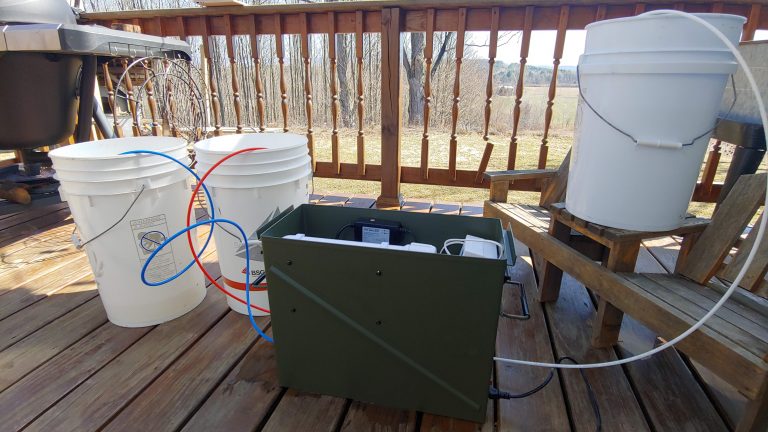This post may contain affiliate links.
Building a log cutting rack is a practical solution for those who rely on wood heat or enjoy outdoor cooking with a wood-fired oven. By gathering your own wood sustainably, you can maintain a self-reliant heat source year after year.
Once you’ve felled a tree and have a stack of long logs ready for processing, a log-cutting rack can be incredibly helpful. The log cutting rack elevates the wood off the ground to a comfortable cutting height, sparing your back from strain and minimizing the risk of damaging your chainsaw chain on the ground.
Here’s a guide on how to build a log cutting rack.

Supplies
- 10 5-foot 2x4s to serve as legs
- 4 10-foot 2x4s to serve as bottom runners
- 10 2-ft 2x4s to serve as cross-stabilizers and log-holding racks (the shelves)
- One box of exterior wood or decking screws, sized to the thickness of your cross-stabilizers/shelves, plus another 1 to 1 1/2 inches to anchor into the legs (typically 1 1/2 or 2 inch length should work fine)
- Square
- Level
- Drill
We recommend pre-drilling holes before installing screws to avoid splitting the wood. Based on experience, nails will pull out from the weight of the logs, which is why we recommend screws.
How to Build Your Log Cutting Rack
Step 1
Lay out five 5-foot leg pieces on level ground, ensuring they’re spaced approximately 2-3 inches farther apart than your desired firewood length. For instance, if aiming for 18-22 inch pieces, space the legs at 24 inches. This allows wiggle room on either side of each “shelf” that supports the logs off the ground.
Step 2
Position one of the 10-foot runners about 4 inches from the bottom of each leg, ensuring even alignment with a square or level. Secure the runner to each leg using two diagonally placed wood screws.
Step 3
Repeat Step 2 to attach another runner approximately 18 inches from the bottom of each leg. Ensure the pieces are square before fixing them with wood screws, as done in Step 2. Set this section aside.
Repeat the above steps to construct the other side of your rack.
Step 4
Lay one assembled side piece flat with the stabilizers on top. Attach a 2-foot 2×4 vertically above the second stabilizer at each intersection with a leg, using two wood screws. This results in five boards sticking up vertically from your stabilizer.
Step 5
With assistance, assemble the first part of your rack by placing the cross-sections from Step 7 on top of the horizontal rail on your second stabilizer side. Hold it in place while attaching the horizontal cross bars to form the first level of your rack, primarily for structural support.
Step 6
Install the next level of 2x4s just below waist height on each leg to hold the wood as you cut it. Another person or a clamp may be needed to hold these in place while drilling and adding screws.
Note: For added stability, consider adding a second set of cross-beams by fixing a 2×4 or pallet wood on the other side of the legs. This increases the rack’s weight but enhances stability, especially if mobility is not a concern.
How to Use Your Log Cutting Rack
Now that you’ve built your log-cutting rack, utilizing it is straightforward. Here’s how:
- Place Wood Sections: Lay a large section of wood over the rack, using multiple pieces if they’re not too thick. Ensure they’re positioned securely.
- Secure Lighter Pieces: For lighter pieces, secure them to the rack using rope or rubber straps to prevent movement during cutting.
- Determine Desired Length: Decide on the desired length for your pieces. For example, we prefer logs that are about 1.5 feet in length.
- Make Cuts: Using a chainsaw, make cuts between the cross-bars of the rack to achieve the desired length for each piece of wood.
Following these steps, you can efficiently cut your wood to size using your newly built log-cutting rack.
Be sure to use appropriate safety equipment including a helmet with face-mask, ear protection, chaps, and steel toed boots!
Carrie Williams Howe is an educational leader by day and an aspiring homesteader by night and weekend. She lives on a small homestead in Vermont with her husband, two children, and a rambunctious border collie. She blogs about her family's homestead life at The Happy Hive.





